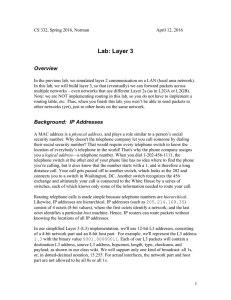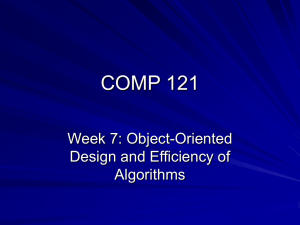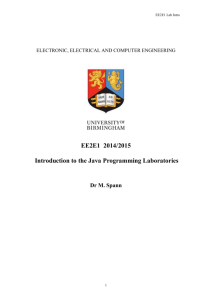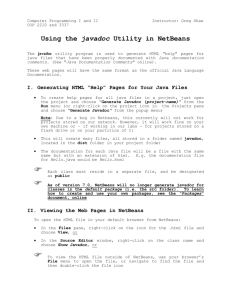Algorithm Efficiency, Big O Notation, and Javadoc
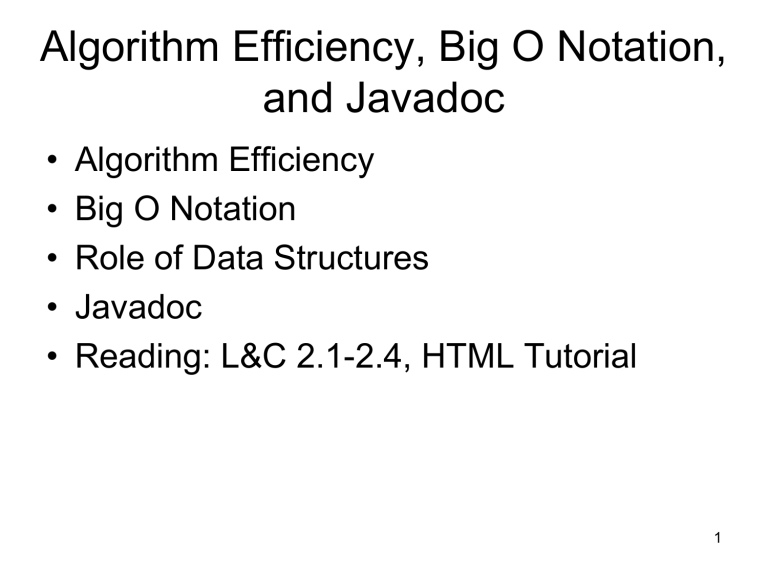
Algorithm Efficiency, Big O Notation, and Javadoc
• Algorithm Efficiency
• Big O Notation
• Role of Data Structures
• Javadoc
• Reading: L&C 2.1-2.4, HTML Tutorial
1
Algorithm Efficiency
• Let’s look at the following algorithm for initializing the values in an array: final int N = 500; int [] counts = new int[N]; for (int i=0; i<counts.length; i++) counts[i] = 0;
• The length of time the algorithm takes to execute depends on the value of N
2
Algorithm Efficiency
• In that algorithm, we have one loop that processes all of the elements in the array
• Intuitively:
– If N was half of its value, we would expect the algorithm to take half the time
– If N was twice its value, we would expect the algorithm to take twice the time
• That is true and we say that the algorithm efficiency relative to N is linear
3
Algorithm Efficiency
• Let’s look at another algorithm for initializing the values in a different array: final int N = 500; int [] [] counts = new int[N][N]; for (int i=0; i<counts.length; i++) for (int j=0; j<counts[i].length; j++) counts[i][j] = 0;
• The length of time the algorithm takes to execute still depends on the value of N
4
Algorithm Efficiency
• However, in the second algorithm, we have two nested loops to process the elements in the two dimensional array
• Intuitively:
– If N is half its value, we would expect the algorithm to take one quarter the time
– If N is twice its value, we would expect the algorithm to take quadruple the time
• That is true and we say that the algorithm efficiency relative to N is quadratic
5
Big-O Notation
• We use a shorthand mathematical notation to describe the efficiency of an algorithm relative to any parameter n as its “Order” or Big-O
– We can say that the first algorithm is O(n)
– We can say that the second algorithm is O(n 2 )
• For any algorithm that has a function g(n) of the parameter n that describes its length of time to execute, we can say the algorithm is O(g(n))
• We only include the fastest growing term and
Eight Growth Functions
• Eight functions O(n) that occur frequently in the analysis of algorithms (in order of increasing rate of growth relative to n):
– Constant
1
– Logarithmic log n
– Linear n
– Log Linear n log n
– Quadratic n 2
– Cubic n 3
– Exponential
2 n
– Exhaustive Search n !
7
Growth Rates Compared
1 n=1 n=2 n=4 n=8 n=16 n=32
1 1 1 1 logn 0 1 2 3
1
4
1
5 n 1 2 4 8 16 32 nlogn 0 2 8 24 n 2 1 4 16 64 n 3 1 8 64 512
64
256
4096
160
1024
32768
2 n n !
2
1
4
2
16
24
256 65536
40320 20.9T
4294967296
Don’t ask!
8
Travelling Salesman Problem Joke
9
Big-O for a Problem
• O(g(n)) for a problem means there is some
O(g(n)) algorithm that solves the problem
• Don’t assume that the specific algorithm that you are currently using is the best solution for the problem
• There may be other correct algorithms that grow at a smaller rate with increasing n
• Many times, the goal is to find an algorithm with the smallest possible growth rate
10
Role of Data Structures
• That brings up the topic of the structure of the data on which the algorithm operates
• If we are using an algorithm manually on some amount of data, we intuitively try to organize the data in a way that minimizes the number of steps that we need to take
• Publishers offer dictionaries with the words listed in alphabetical order to minimize the length of time it takes us to look up a word
11
Role of Data Structures
• We can do the same thing for algorithms in our computer programs
• Example: Finding a numeric value in a list
• If we assume that the list is unordered, we must search from the beginning to the end
• On average, we will search half the list
• Worst case, we will search the entire list
• Algorithm is O(n), where n is size of array
12
Role of Data Structures
• Find a match with value in an unordered list int [] list = {7, 2, 9, 5, 6, 4}; for (int i=0; i<list.length, i++) if (value == list[i]) statement; // found it
// didn’t find it
13
Role of Data Structures
• If we assume that the list is ordered, we can still search the entire list from the beginning to the end to determine if we have a match
• But, we do not need to search that way
• Because the values are in numerical order, we can use a binary search algorithm
• Like the old parlor game “Twenty Questions”
• Algorithm is O(log
2 n), where n is size of array
14
Role of Data Structures
• Find a match with value in an ordered list int [] list = {2, 4, 5, 6, 7, 9}; int min = 0, max = list.length-1; while (min <= max) { if (value == list[(min+max)/2]) statement; // found it else if (value < list[(min+max)/2]) max = (min+max)/2 - 1; else min = (min+max)/2 + 1;
} statement; // didn’t find it
15
Role of Data Structures
• The difference in the structure of the data between an unordered list and an ordered list can be used to reduce algorithm Big-O
• This is the role of data structures and why we study them
• We need to be as clever in organizing our data efficiently as we are in figuring out an algorithm for processing it efficiently
16
Javadoc
• Javadoc is a JDK tool that creates HTML user documentation for your classes and their methods
• In this case, user means a programmer who will be writing Java code using your classes
• You can access Javadoc via the JDK CLI:
> javadoc MyClass.java
• You can access Javadoc via Dr Java menu:
Tools > Javadoc All Documents
Tools > Preview Javadoc for Current Document
17
Javadoc
• The Javadoc tool scans your source file for specialized multi-line style comments:
/**
* <p>HTML formatted text here</p>
*/
• Your Javadoc text is written in HTML so that it can appear within a standardized web page format
18
Block Tags for Classes
• At the class level, you must include these block tags with data (each on a separate line):
/**
* @author Your Name
* @version Version Number or Date
*/
• You should include HTML text describing the use of this class and perhaps give examples
19
Block Tags for Methods
• At the method level, you must include these block tags with data (each on a separate line):
/**
* @param HTML text for 1st parameter
* @param HTML text for 2nd parameter
* . . .
* @return HTML text for return value
*/
• If there are no parameters or return type, you can omit these Javadoc block tags
20
In Line Tags
• At any point in your Javadoc HTML text, you may use In-Line Tags such as @link:
/**
* <p>See website {@link name url}
* for more details.</p>
*/
• In-Line tags are always included inside { }
• These { } are inside the /** and */ so the compiler does not see them
21
HTML Coding
• To the extent that time permits:
– HTML Coding for text formatting
– Questions on HTML and use in Javadoc
22
![[#BATCH-1941] SimpleRetryPolicy javadoc is missing some](http://s3.studylib.net/store/data/007288034_1-33c42ec598aae6809f8195d54f616bc9-300x300.png)
